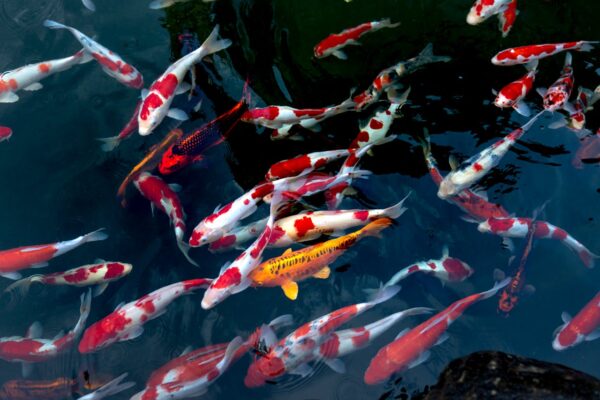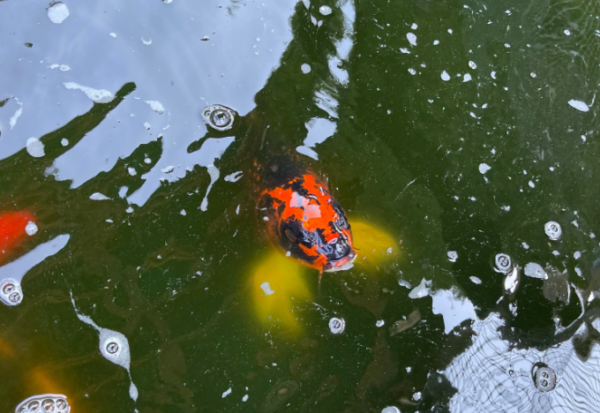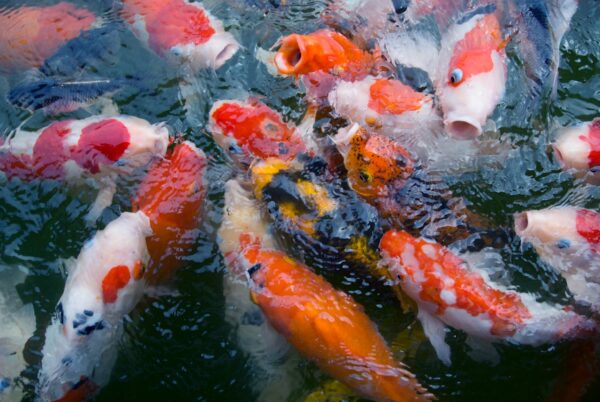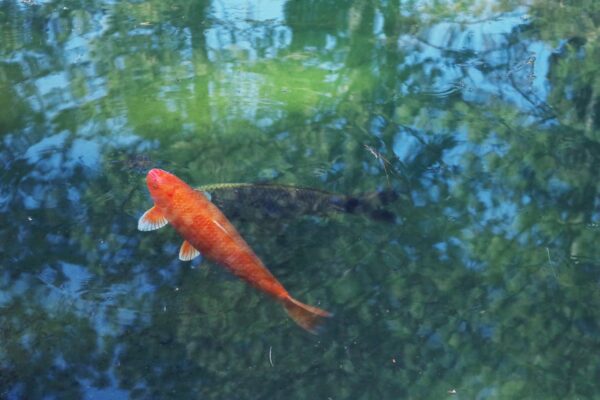Bred from colorful carp species in early 19th century Japan, Koi are considered a sign of good fortune and health. Koi are mostly found captive in outdoor ponds and larger indoor aquariums. Despite being a pretty resilient species, Koi have specific nutritional requirements that vary with their age, season, and size.
As a beginner Koi keeper, you’ve come to the right place to get informed about the feeding habits of your Koi fish and how to adjust their diet based on different factors.
Table of Contents
Natural Diet and Nutritional Requirement of Koi Fish

Koi are rarely found in wild waters, but they often get released and find their way into canals and rivers. As descendants of traditional carp, given the water parameters are suitable, they can survive and thrive in the wild without any significant issues.
What do Koi Fish Eat in the Wild?
Being omnivorous creatures, wild Koi fish would eat algae, worms, larvae, small crustaceans, and submerged vegetation to survive.
Depending on the nature of the ecosystem, they may even stir up the bottom to eat seeds and other buried organic matter.
Nutritional Requirements
Koi fish require a balanced diet to stay healthy and grow. Their nutritional requirements usually vary depending on their age, water temperature, and activity level, but we’ve compiled a rough guideline for your convenience:
Protein
A high-protein diet is essential for Koi fish as their digestive system can’t handle carbohydrates quite well. A 30-38% protein must be included in their diet. Your Koi won’t benefit from any additional protein. It’s also necessary to incorporate high-quality protein sources to fulfill the different amino acid requirements.
Fats and Oil
The optimal fat content for Koi is 5-10%. Fats are the primary source of energy for Koi fish, and they also play a role in maintaining various metabolic processes. While Koi can utilize protein for energy, optimal fat content in the diet allows protein to be used for growth and tissue repair.
Carbohydrates
Excess carbohydrates can lead to digestive problems and water quality issues in Koi ponds. It’s better to avoid introducing any additional carbohydrates in your Koi Fish diet over what’s already present in the fish meal and the occasional veggies.
Vitamins and Minerals
A variety of vitamins in trace amounts are necessary for your Koi Fish to physiologically function. Most commercial Koi foods include vitamins A, C, D, E, B-complex, and K vitamin. Minerals, including calcium, phosphorus, and iodine, are also essential for bone development, enzyme functions, and other critical bodily processes.
Also Read: Green Hair Algae: 3 Quick Fixes & Get Rid Of Them Easily
Types of Koi Fish Food That You Can Feed

Kois aren’t picky eaters. They try to devour anything that can be accommodated into their mouths. In doing it, they often try to benignly nibble on decorative leaves and other fish species. Here are a few Koi food options available in stores that you can choose from depending on your preference:
Flake Food
Flake food choices are particularly effective if you have juvenile Koi Fish in your pond. A balanced flake food can deliver all the necessary nutrients for optimal growth and coloration. Koi Flakes are available in different sizes depending on the juveniles’ age. Larger Koi might not see the flakes and ignore them altogether.
Flakes are cheaper but also much less dense than pellet foods.
Pellet Food
Pellets are outright the best Koi food alternatives. Being bigger, larger Koi fish can see and devour them without any issues. They’re also dense in protein, fat, vitamins, and natural color supplements (spirulina and beta-carotene). Moreover, pellets don’t cloud the water as much as the flakes do. Pellets, however, are costlier, and most varieties are not suitable for juvenile Koi.
Live/Frozen Food
Live/frozen brine shrimp, bloodworms, and other food, bought from reliable sources can be fed to your Koi fish. However, we don’t recommend regular inclusion of live foods in the diet as it can cause parasitic infections and introduce water quality issues in the tank.
Consider live/frozen foods as treats to occasionally reward your Koi with.
Spirulina Algae and Wheat Germ
Cyanobacterium or spirulina algae are free-floating blue-green algae that enhance Koi coloration and improve fat break down to gain energy. Spirulina is available in small pellet forms that can be occasionally supplemented with regular food to derive the benefits. Most high-quality pellets already contain spirulina.
Wheat germ, on the other hand, is a rich natural source of vitamins, protein, fiber, and fat. It often aids in digestion and promotes a better growth rate.
Floating Food Vs Sinking Food
When it comes to Koi Fish food, a debate always ensues about whether to offer floating food or sinking food. Fueling the confusion further, both Flakes and Pellets come in floating and sinking variations.
Here are the benefits of giving floating food to your Koi Fish:
- Koi are natural surface feeders, so floating food aligns with their feeding instincts.
- You can easily observe koi activity and health as they eat at the surface. This makes assessing their appetite and identifying any potential health issues easier.
- Floating food stays visible. Uneaten pellets can easily be removed, preventing them from sinking and decaying in the pond.
- Floating food is generally less expensive than sinking food.
- Floating food often comes in a wider variety to target specific styles of growth or color enhancements.
Benefits of offering sinking food to your Koi Fish:
- Sinking food ensures all fish in the pond, including smaller Koi Fish who can’t compete, get their share of nutrition. It’s also better if you have bottom feeders, such as loaches and catfish, in the pond.
- Sinking food makes it harder to overfeed at the surface by hand.
- Sinking food promotes natural foraging behavior in koi. They often rummage around the bottom for food.
- Sinking food is less likely to clog filters or skimmers. Floating foods often get broken down and carried by water currents.
Also Read: Healthy Food For Your Guppies
The Best Food Ingredients for Koi Fish

Let’s discuss the most common Koi food ingredients so you can review the products and see if they’re best for your Koi.
Fish Meal, Squid Meal, Shrimp Meal
These finely ground meals are all excellent sources of high-quality protein. They provide essential amino acids that koi need for growth, repair, and reproduction. They are also naturally preferred to koi, thanks to their taste and smell.
Additionally, these meals contain healthy fats and oils that provide energy, especially during colder months.
Wheat Germ
Wheat germ is a valuable addition to koi food as it’s packed with vitamins and minerals, particularly vitamin E and B complex. These vitamins help maintain healthy skin and blood cells. They also have an anti-aging effect on koi.
Corn Meal
Primarily a source of carbohydrates, cornmeal provides energy for koi, especially in colder months when their metabolism has slowed down.
Soybean meal
A plant-based alternative to animal protein, soybean meal offers a decent protein source. Soybean meal also provides some dietary fiber, which can aid digestion.
Spirulina
It’s a rich source of vitamins, minerals, and antioxidants that give koi’s immune system a boost. Spirulina also promotes vibrant coloration in koi.
Blanched vegetables
Occasionally, you can offer koi a treat of chopped or blanched vegetables like lettuce, spinach, or zucchini. However, these should only be a small part of their diet and not a substitute for balanced koi food.
Koi Fish Diet Restrictions
Here are some foods that you should never feed your Koi Fish, even as a treat:
Anything Wild Caught
Wild-caught insects, fish, and larvae carry parasites and diseases your Koi may not be resilient to. It can infect the whole pond and irradicate your whole Koi collection. Wild-caught prey may also not provide enough nutrition to balance the diet.
Peas
Peas are a good source of vitamins for some fish, but Koi can have difficulty swallowing and digesting the tougher outer shell. It can lead to bloating, constipation, and swim bladder problems.
Corn
Whole corn kernels present a choking hazard to Koi fish, especially if they’re smaller. Moreover, it’s full of carbohydrates that can lead to digestive issues and poor water quality situations.
White Bread
Mostly carbs, white bread doesn’t offer any nutritional value when included in the Koi diet. Uneaten bread quickly decomposes in the pond and can lead to algae bloom and water quality issues.
Also Read: Best 9 Hang-On Back (HOB) Protein Skimmers For Aquarium
How to Feed Your Koi Fish

Koi are cold-blooded creatures and rely on environmental temperature to digest their food. Their metabolism—ability to derive energy from food—reduces to almost a halt during colder months and can skyrocket during warmer weather. Here is how to feed your Koi fish:
During Warmer Months (>70°F)
Feed your Koi Fish 2-3 times a day during the warmer months. They’re most active during the months when the temperature is above 70°F.
During Cooler Weather (50-70°F)
As the weather cools, you can visibly observe their reduced activity and appetite. Reduce feeding to once a day during these months when the temperature is between 50-70°F.
During Cold Weather (<50°F)
At a significantly low temperature of below 50°F, the digestive system of Koi Fish virtually shuts down, and they hibernate during these months. Seize feeding until the weather warms a bit in the coming months, as the uneaten food can decompose and cause water quality issues.
5-Minute Rule
Feed your Koi Fish only what they can comfortably eat within 5 minutes. This helps prevent overfeeding, which can lead to water quality issues and health problems for your Koi.
Observe Feeding Activity
Pay attention to your Koi’s feeding behavior. If they are fighting for food or gobbling it all up too quickly, you might be underfeeding. On the other hand, if food remains uneaten after 5 minutes, you must reduce the feeding volume. Adjust the quantity accordingly.
Feed Depending on Fish Size
The size of your Koi should also be considered. Younger Koi grow rapidly and may need slightly more food than mature Koi Fish.
Tips for Koi Fish Feeding
- Feed your Koi Fish multiple times a day, even up to 5 times a day during winter, in small portions. This practice maintains water quality and prevents overfeeding.
- Choose high-quality Koi food rich in essential nutrients that promote vibrant colors and health.
- Avoid feeding your Koi during colder months as their metabolism might slow down.
- Introduce occasional live/frozen treats to maintain variety in the diet.
- Remove uneaten food after feeding to maintain water quality.
- Feed your Koi Fish at the same spot each time to encourage them to gather together.
- Always monitor your Koi Fish for any signs of bloating, lethargy, or unusual activities.
Also Read: Nano Protein Skimmer: Why I Need It?
FAQs
Commercial pellets and flakes are the best food for Koi Fish. Some aquarists supplement their diet with spirulina, wheat germ, and blanched veggies.
Koi Fish eat everything, including rice. But, rice shouldn’t be a part of their regular diet as it’s a rich source of carbohydrate that has no use in a Koi’s system expect bloating it.
In summer, feed your Koi 4 times a day, in colder months above 70F, feed once a day, and in winter months, avoid feeding altogether.
The Bottom Line
We’ve discussed all the necessary details of Koi Fish Feeding. Hope now you’ll be able to properly feed your Koi and get the best out of their elegant size and coloration.
